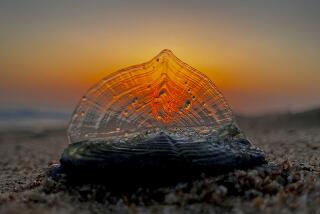Newly Found Relative of Jellyfish Lures With Light
Scientists have discovered a jellyfish-like creature a mile below the ocean’s surface that is the first marine invertebrate to use red fluorescent light to lure prey.
The researchers, led by Steven Haddock of the Monterey Bay Aquarium Research Institute, used robotic submarines to capture specimens from depths of 5,200 to 7,500 feet, roughly 50 miles off the Central California coast.
The specimens were found to be a previously unknown species of the genus Erenna. The creatures, which are still unnamed, are siphonophores -- animals including coral and the Portuguese man-of-war that are colonies of many organisms functioning as a single unit.
The roughly foot-long, tubular creature is covered with tentacles. The tentacles have numerous branches attached to a central stalk.
Inside the stalk are spots that emit light, the researchers reported in the current issue of the journal Science.
The young creatures emit blue-green light, not red, generated by internal chemicals. In mature animals, these glowing spots are covered by a fluorescent substance that absorbs the blue-green light and retransmits the energy as red light.
Attracted to the twitching lights, prey are tangled in the tentacles and then pierced by tiny harpoon-like cells that inject paralyzing toxins.
The use of glowing lures is rare in the sea, the researchers said. Many organisms are thought to produce light for defensive purposes. Only a few species, such as anglerfish, which dangle glowing appendages in front of their mouths, have been shown to lure with light.
The use of red light is also rare, the scientists said. The wavelengths of red light do not penetrate the watery darkness very well, and the prevailing thought has been that deep-sea creatures couldn’t detect such colors.
More to Read
Sign up for Essential California
The most important California stories and recommendations in your inbox every morning.
You may occasionally receive promotional content from the Los Angeles Times.








